Cagiva
This article needs additional citations for verification. (August 2019) |
Coordinates: 45°48′13″N 8°46′42″E / 45.8035942°N 8.7782452°E
| Type | Subsidiary |
|---|---|
| Industry | Motorcycle manufacturing |
| Predecessor | Aermacchi Harley-Davidson |
| Founded | 1950 (Motocycle: 1978) |
| Founder | Giovanni Castiglioni |
| Headquarters | , Italy |
| Products | Motorcycle |
| Parent | MV Agusta Motor S.p.A. |
| Website | www.cagiva.it |
Cagiva is an Italian motorcycle manufacturer. It was founded in 1950 by Giovanni Castiglioni in Varese, originally producing small metal components. Giovanni's sons, Claudio and Gianfranco Castiglioni went into the motorcycle industry in 1978. The name is a portmanteau derived from the founder's name 'Giovanni Castiglioni' and the founding location, i.e. CAstiglioni GIovanni VArese.
In its history, Cagiva won races in Dakar and Motocross competitions, as well as in Grand Prix motorcycle racing.
History[]

In 1978 Cagiva entered the motorcycle business with two racing motorcycles ridden by Gianfranco Bonera and Marco Lucchinelli. In the same year it bought a factory in Varese's frazione of Schiranna from Aermacchi/AMF-Harley-Davidson and went into motorcycle production. By 1979 the company reached an annual production of 40,000 motorbikes, with eight models powered by two-stroke engines ranging from 125 cc to 350 cc.
Many of the Harley-Davidson models were continued in production as Cagivas, and the off-road motorcycle division was improved and expanded, eventually producing its own race-winning WMX series of moto-cross motorcycles.


In 1983 Cagiva also sourced Ducati four stroke v-twin engines from 350 cc to 1000 cc and entered the big displacement market. Cagiva bought Ducati in 1985, but kept the Ducati brand that was better recognized outside Italy. Ducati motorcycle production continued in Bologna, while the Varese-built Cagiva Ala Azzurra (sold under the name "Alazzurra", "Bluewing") and Elefant were introduced, both featuring Ducati engines.[2]
Cagiva continued with strategic buyouts of Moto Morini in 1985 and Husqvarna in 1987. In 1991 Cagiva also bought the trademarks for the MV Agusta brand.
In 1996, Cagiva accepted the offer by the Texas Pacific Group and sold the Ducati and Moto Morini brands. In 1999, for strategic purposes, the company was restructured. MV Agusta Motor become the main brand comprising Cagiva and Husqvarna.[3]
In 2000, production of the Cagiva Roadster ended. In 2008, Harley-Davidson bought MV Agusta Motor, the parent company of Cagiva, thereby regaining some control of its old Aermacchi factory.
In October 2009, Harley-Davidson informed that it would put Cagiva up for sale. In the August of the following year, Cagiva was bought back by the son of the founder and former owner Claudio Castiglioni.
In 2012, production of new high engine capacity Mitos ended. Increasingly stringent environmental emission requirements and the concentration of resources on MV Agusta's F3 were cited as reasons. The last few Mito SP525s produced were white in colour, and personally signed by MV Agusta CEO Giovanni Castiglioni, thus ended the legacy of the Mito, alongside the end of the Raptors.
Last Cagiva-branded bikes were Raptor and Mito 125cc. The Cagiva brand is no longer active, the production being focused on MV Agusta.
Racing[]
In the early 1980s Cagiva began to manufacture dirt bikes and started a massive public relations program with the opening of its North American branch. It hired Ron Turner and Duane Summers to test and develop its bikes. Cagiva motocross bikes were characterized by their fast powerful engines and innovative features, such as the MX line that had only one spring in the front forks with one fork controlling rebound and the other compression.
500cc World Championship[]
At the end of the 1970s the company began campaigning the Grand Prix motorcycle racing circuit. Randy Mamola was its lead rider from 1988 to 1990, and he achieved Cagiva’s first podium result. It would also have some technical assistance from Yamaha. In 1991 it signed former world champion Eddie Lawson to its team. Lawson would claim the company's first victory when he won the 1992 Hungarian Grand Prix. John Kocinski would also win a Grand Prix on a Cagiva GP500 (C594), finishing third in the 1994 world championship.
Dakar Rally[]

In 1990 and 1994 the Italian rider Edi Orioli won the Dakar Rally on the Ducati-powered Cagiva Elefant.
| Year | Champion | Motorcycle |
|---|---|---|
| 1990 | Cagiva Elefant | |
| 1994 | Cagiva Elefant |
Motocross World Championship[]
- 125 cc class
| Year | Champion | Motorcycle |
|---|---|---|
| 1985 | Cagiva WMX | |
| 1986 | Cagiva WMX |
Motocross World World Constructors champions[]
- 125 cc class
- 1985, 1986, 1987

Italian Speed championship[]
| Year | Champion | Class | Motorcycle |
|---|---|---|---|
| 1990 | Open | ||
| 1991 | Open | ||
| 1992 | Open | ||
| 1994 | Supermono |
Mini Moke[]
Cagiva bought BMCs design for the Mini Moke, manufacturing them in Portugal using British built engines from 1990 until 1993. Intending to transfer production to the Bologna factory early in 1995, the tooling for the Moke was transferred to Italy late in 1993, but production never restarted.
Models[]
Racing motorcycles[]
| Model | Engine | Years | Notes | Image |
|---|---|---|---|---|
| 1C2 | (1980) | |||
| 2C2 | (1981) | |||
| 3C2 | (1982) | |||
| 4C3 | () |  Cagiva 4C3 | ||
| () | ||||
| C10 | (1985-1986-1987) |  Cagiva C10 | ||
| C587 | (1987) | |||
| C588 | (1988) | |||
| C589 | (1989) | |||
| C590 | (1990) | |||
| (1991) |  Cagiva C591 | |||
| C592 | (1992) | |||
| C593 | (1993) |  | ||
| C594 | (1994) |  Cagiva C594 | ||
| F4 | (1995-1996) | prototype, Ferrari engine |  Cagiva F4 | |
| Mito Mk II SP | () | The first bike of Valentino Rossi |  Mito Mk II Sport Production official of the 1993 Lucky Explorer team driven by Valentino Rossi and Vittoriano Guareschi | |
| Elefant 750 Elf-Ligier | (1985) | Ducati engine |
Road[]
| Model | Engine | Years | Notes | Image |
|---|---|---|---|---|
| Alazzurra 350 / 350 GT | 349 cc, 90° L-twin, 4-stroke engine, SOHC, desmodromic 2-valves, air-cooled | (1984-1985) | Ducati engine (Ducati Pantah) |  Cagiva Alazzurra 350 GT |
| Alazzurra 400 / 400 GT | 90° L-twin, 4-stroke engine, SOHC, desmodromic 2-valves, air-cooled | (1986) | Ducati engine (Ducati Pantah) | |
| Alazzurra 650 / 650 GT | 649,5 cc, 90° L-twin, 4-stroke engine, SOHC, desmodromic 2-valves, air-cooled | (1984-1986) | Ducati engine (Ducati Pantah) | |
| Aletta Oro S1 / S2 | 124,63 cc, Single, Two-stroke engine, Reed valve, liquid cooling | (1985-1987) | ||
| Blues | 124,63 cc, Single, Two-stroke engine, Reed valve, liquid cooling | (1987-1993) | ||
| Freccia C9 | 124,63 cc, Single, Two-stroke engine, Reed valve, liquid cooling | (1987) | ||
| Freccia C10R / C10 Anniversary | 124,63 cc, Single, Two-stroke engine, Reed valve, liquid cooling | (1988) |  Cagiva C10 Anniversary | |
| Freccia C12R / C12 SP | 124,63 cc, Single, Two-stroke engine, Reed valve, liquid cooling | (1989-1990) |  Cagiva Freccia C12R | |
| Mito | 124,63 cc | () |  Cagiva Mito, 1992 | |
| Mito Mk II | 124,63 cc | () | ||
| Mito Ev | 124,63 cc | () | 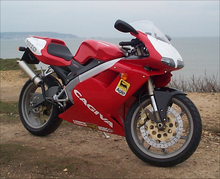 Cagiva Mito Evolution II, 2001 | |
| Mito SP525 | 124,63 cc | () | 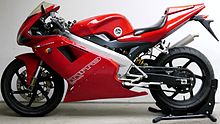 Mito SP525 | |
| SST 125 | () | |||
| SST 175 | () | |||
| SST 250 | () | |||
| SST 350 | () | |||
| SuperCity 125 | () | |||
| Roadster 521 | () | |||
| Roadster 200 | () | |||
| Low Rider 125 | () | 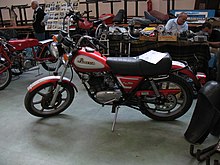 Cagiva Low Rider 125 | ||
| Planet | 124,63 cc, Single, Two-stroke engine, Reed valve, liquid cooling | (1997-2003) | Mito engine |  Cagiva Planet 125 |
| River 500 | () | |||
| River 600 | () | |||
| Raptor 125 | 124,63 cc, Single, Two-stroke engine, Reed valve, liquid cooling | (2003-2007) | Mito engine | |
| Raptor 650 | 645,5 cc, 90° V-twin, 4-stroke engine, DOHC, 4-valves, liquid cooling | (2001-2007) | Suzuki engine, (SV650) |  Cagiva Raptor 650 |
| V-Raptor 650 | 645,5 cc, 90° V-twin, 4-stroke engine, DOHC, 4-valves, liquid cooling | (2001-2004) | Suzuki engine, (SV650) |  Cagiva V-Raptor 650 |
| Raptor 1000 | 996 cc, 90° V-twin, 4-stroke engine, DOHC, 4-valves, liquid cooling | (2000-2006) | Suzuki engine, (TL1000S) |  Cagiva Raptor 1000 |
| V-Raptor 1000 | 996 cc, 90° V-twin, 4-stroke engine, DOHC, 4-valves, liquid cooling | (2000-2006) | Suzuki engine, (TL1000S) | 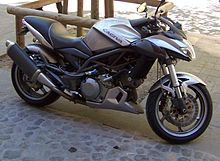 Cagiva V-Raptor 1000 |
| Xtra Raptor 1000 | 996 cc, 90° V-twin, 4-stroke engine, DOHC, 4-valves, liquid cooling | (2002-2006) | Suzuki engine, (TL1000S) |  Cagiva Xtra Raptor 1000 |
Off road[]
- MXR 250
- WMX 125
- WMX 200
- WMX 220
- WMX 250
- WMX 500
- RX 250
- MXR 500
Adventure - dual sport[]
| Model | Engine | Years | Notes | Image |
|---|---|---|---|---|
| SXT 125 | () |  Cagiva SXT, 1984 | ||
| SXT 175 | () | |||
| SXT 250 | () | |||
| SXT 350 | () | |||
| T4 350 E / T4 350 R | 343 cc, Single, 4-stroke engine, SOHC, 4-valves, Air-cooled engine | (1987-1991) |  | |
| T4 500 E / T4 500 R | 452 cc, Single, 4-stroke engine, SOHC, 4-valves, Air-cooled engine | (1987-1991) | ||
| Ala Blu 125 | () | |||
| Ala Blu 250 | () | |||
| Ala Blu 350 | () | |||
| Aletta Rossa 125 | 124,63 cc, Single, Two-stroke engine, Reed valve, liquid cooling | (1983-1987) |  Cagiva Aletta Rossa 125 | |
| Aletta Rossa 200 | cc, Single, Two-stroke engine, Reed valve, liquid cooling | (1984-1986) | ||
| Ala Rossa 350 | 343 cc, Single, 4-stroke engine, SOHC, 2-valves, Air-cooled engine | (1983-1988) | ||
| Elefant 125 | () | |||
| Elefant 200 | () | |||
| Elefant 350 | () | Ducati engine | ||
| Elefant 650 | () | Ducati engine |  Cagiva Elefant 650 | |
| Elefant 750 | 748 cc, 90° V-twin, 4-stroke engine, Desmodromic valve, 2-valves, Air-cooled engine-Oil cooling | (1987-1998) | Ducati engine |  Cagiva Elefant 750 MK1  Cagiva Elefant 750 AC |
| Elefant 900 i.e. Elefant 900 i.e. GT Elefant 900 AC Elefant E900 Elefant Marathon 944 Ducati E900 (North American market) |
904 cc, 90° V-twin, 4-stroke engine, Desmodromic valve, 2-valves, Air-cooled engine-Oil cooling | (1991-1997) | Ducati engine |  Cagiva Elefant 900 i.e. 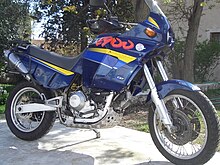 Elefant 900 AC |
| Canyon 500 | 498 cc, Single, 4-stroke engine, SOHC, 4-valves, Air-cooled engine-Oil cooling | (1997-2002) | ||
| Canyon 600 | 601,4 cc, Single, 4-stroke engine, SOHC, 4-valves, Air-cooled engine-Oil cooling | (1995-1998) | ||
| Gran Canyon | 904 cc, 90° V-twin, 4-stroke engine, Desmodromic valve, 2-valves, Air-cooled engine-Oil cooling | (1998-2000) | Ducati engine | 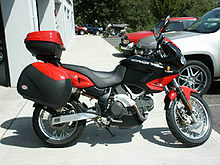 Cagiva Gran Canyon |
| W8 | 124,63 cc, Single, Two-stroke engine, Reed valve, liquid cooling | (1991-1995) | A cheaper version was subsequently produced until 1999 with an air-cooled thermal unit without an exhaust valve and the piston exclusively of the two-band type, furthermore the silencer was replaced with a painted iron model. |  Cagiva W8 |
| W12 | 343 cc, Single, 4-stroke engine, SOHC, 4-valves, Air-cooled engine | (1993-1996) |  Cagiva W12 supplied to the Italian Army | |
| W16 | 601,41 cc, Single, 4-stroke engine, SOHC, 4-valves, Air-cooled engine | (1994-2001) | GoldenEye - Pierce Brosnan Cagiva 600 W16 In the pre-title sequence of GoldenEye set in Russia's Arkangel facility, Bond is in trouble. He retrieves a Cagiva motorcycle from a dispatched guard and accelerates down a runway in pursuit of a pilot-less aeroplane - his only escape. | 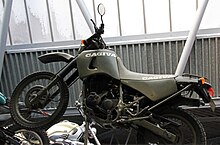 Cagiva W16 in National Motor Museum, Beaulieu |
| Cruiser | 124,63 cc, Single, Two-stroke engine, Reed valve, liquid cooling | (1987-1989) | Freccia C9 engine | |
| Tamanaco | 124,63 cc, Single, Two-stroke engine, Reed valve, liquid cooling | (1988-1991) | Freccia C10 engine | |
| N90 | 124,63 cc, Single, Two-stroke engine, Reed valve, liquid cooling | (1990-1991) | Mito engine | |
| Navigator 1000 | 996 cc, 90° V-twin, 4-stroke engine, DOHC, 4-valves, liquid cooling | (2000-2005) | Suzuki engine, (TL1000S) |  Cagiva Navigator 1000 |
Moped and Scooter[]
- Cocis
- Prima 50 / Prima 75
- SuperCity 50 / SuperCity 75
- Mito 50
- W4 50 / W4 75
- Passing 50cc (Scooter)
See also[]
- List of Italian companies
- List of motorcycle manufacturers
References[]
- ^ "Esercito: al 'Motodays' con moto storiche e l'ultima nata, la Cagiva 350 (2)". Archived from the original on 2014-03-06. Retrieved 2015-01-11.
- ^ 1985-1987 Cagiva Alazzurra Motorcycle Classics article, Jan/Feb 2008
- ^ "Cagiva Recent Facts". Cagiva. Archived from the original on 2008-02-15. Retrieved 2008-02-03.
External links[]
| Wikimedia Commons has media related to Cagiva. |
- Cagiva
- Motorcycle manufacturers of Italy
- Italian brands
- Vehicle manufacturing companies established in 1978
- Italian companies established in 1950
- MV Agusta

